 |
|
 |
The Inland Revenue Department raises revenue through taxes, duties and fees in accordance with the relevant legislations. While the duties and fees collected for a year are based on the actual results of the year, the earnings and profits tax are principally assessed by reference to the incomes / profits of the taxpayers in the previous year. For 2008-09, the earnings and profits tax assessed increased by $6.5 billion (4.7%), as compared with the previous year. The total of duties and fees collected, however, dropped by 32.3%.
Profits Tax
Profits tax is levied on individuals, corporations, bodies of persons and partnerships in respect of assessable profits arising in or derived from Hong Kong. From 1 April 2008, the tax rates for corporations and non-corporate persons were both reduced by 1% to 16.5% and 15% respectively.
The Hong Kong economy has slowed down since the second half of 2008-09 as a result of the global financial crisis. Nevertheless, profits tax assessed in the year recorded at $103.6 billion (Figure 5), $7.7 billion (8%) more than that of the previous year, reflecting the rapid economic growth in 2007-08. Of the total tax assessed, the property and financial sectors together contributed 47.3% (Figure 6). Further statistics relating to the tax assessed in respect of different business sectors are shown in Schedules 3 and 4.
Figure 5 Profits tax assessed
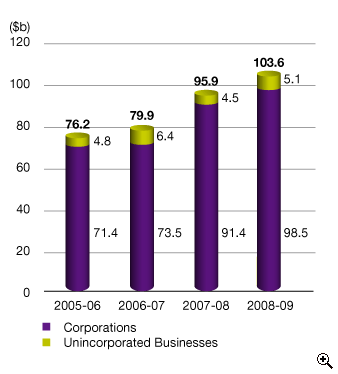
Figure 6 Corporate profits tax assessed ratios by business sectors
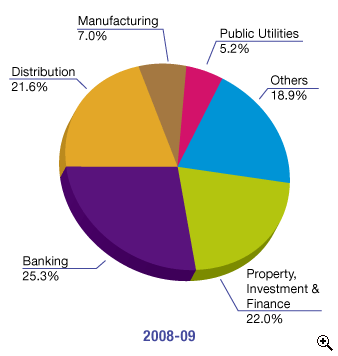
|
Salaries Tax
Salaries tax is charged on all income arising in or derived from Hong Kong from any office (e.g. a directorship), employment or pension. The total tax payable is restricted to an amount not exceeding the standard rate of salaries tax of the net total income (without allowances) of the individual concerned. For the year of assessment 2008-09, the standard rate was reduced from 16% to 15%.
Compared with the previous year, the number of assessments made increased by 5.4%. 1.6% more tax was assessed during 2008-09 (Figure 7). Analyses of tax assessed and allowances granted in respect of taxpayers at various income levels are provided in Schedules 5 and 6.
Figure 7 Salaries tax assessments
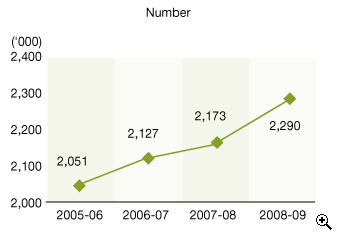
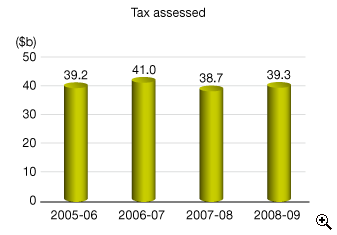
Reflecting the widening of tax bands and reduction in marginal tax rate, the number of standard rate taxpayers greatly decreased by 27,237 from 36,706 last year to 9,469 this year. These taxpayers together contributed 36.3% of the salaries tax assessed, compared to 48.6% last year (Figure 8).
Figure 8 Standard rate taxpayers
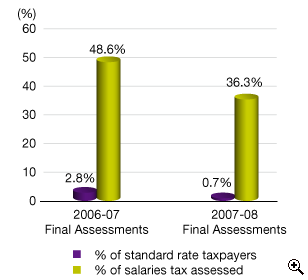
Notification Requirements of Employers
Apart from reporting commencements and cessations of employments, employers are required to prepare annual returns to report the emoluments of each of their employees. During the year, 271,093 employers filed employer's returns with the Department.
The Department provides e-Seminars and disseminates tax information to employers on the IRD Homepage in order to enhance their understanding of the relevant statutory requirements. The contents relate to completion of employer's return, employer's obligation, answers to frequently asked questions, etc. Employers can also obtain specimens of completed employer's return and notification forms through the Fax-A-Form service.
|
Property Tax
Property owners (including corporations) are subject to property tax which is charged at the standard rate in respect of the net assessable value of the property. For the year of assessment 2008-09, the standard rate was lowered from 16% to 15%. Incorporated and unincorporated businesses that pay property tax in respect of their business premises can have such payments set off against their profits tax liabilities. For corporations, income arising from properties owned by them is also subject to profits tax at the corporate rate. To obviate the need for yearly set-off of property tax against profits tax, a corporation can apply for exemption of property tax on the property concerned.
Statistics on the classification and ownership of properties, based on the records of the Department, are provided in Schedule 7. The number of assessments made in 2008-09 was 2.94% more than the previous year whereas the amount of property tax assessed decreased by 36% because of the tax reduction for the year of assessment 2007-08 (Figure 9).
Figure 9 Property tax assessments
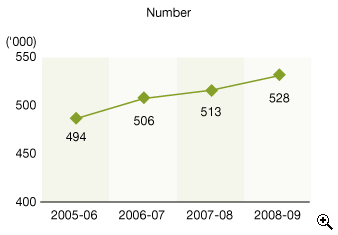
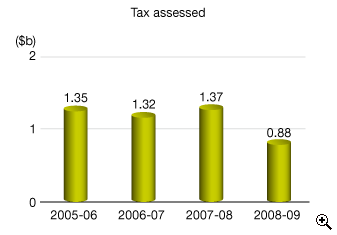
|
Personal Assessment
An individual may elect personal assessment in respect of his or her total income. Under personal assessment, all the incomes of the taxpayer and his or her spouse are aggregated and, after the deduction of all allowances, assessed at the graduated tax rates. In appropriate circumstances, this reduces the total tax liability of the individual (e.g. an individual who would otherwise be chargeable at the standard rate on each separate income source). The number of assessments made in 2008-09 was 5.4% less than the previous year and the amount of tax assessed decreased by 38.9% because of the tax reduction for the year of assessment 2007-08 (Figure 10).
Figure 10 Assessments made under personal assessment
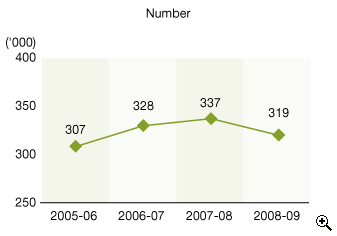
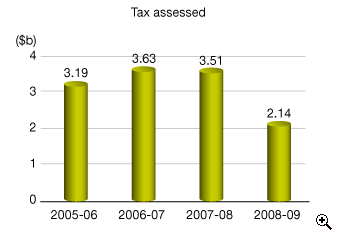
|
Advance Ruling
The advance ruling service allows a person to apply for a ruling on how a provision of the Inland Revenue Ordinance applies in relation to a particular arrangement.
A fee is charged for the service on a "cost recovery" basis. The applicant is required to pay an initial application fee of $30,000 for a ruling concerning the "Territorial Source Principle", or $10,000 for a ruling on any other matter.
The Department endeavours to provide a ruling within 6 weeks of the date of application, provided that all relevant information is furnished with the application and further information from the applicant is not required.
During the year, 42 advance ruling applications were processed (Figure 11). Most of the applications were for rulings on profits tax matters.
Figure 11 Advance rulings
| |
|
|
|
2007-08
Number |
|
|
|
2008-09
Number |
|
| |
Awaiting decision at the beginning of the year |
|
|
15 |
|
|
|
12 |
|
| |
| Add: |
|
Application received during the year |
|
|
|
47 |
 |
|
|
|
|
49 |
 |
|
|
| |
|
|
|
62 |
|
|
|
61 |
|
| |
|
|
|
|
|
|
|
|
|
| |
 |
|
Ruling made |
|
33 |
|
|
|
29 |
|
|
|
| |
 |
|
Application withdrawn |
|
12 |
|
|
|
8 |
|
|
|
| |
 |
|
Ruling declined |
|
5 |
 |
|
|
50 |
 |
|
|
5 |
 |
|
|
42 |
 |
|
|
| |
Awaiting decision at the end of the year |
|
|
|
|
|
|
|
|
|
Objection
A taxpayer who is aggrieved by an assessment made under the Inland Revenue Ordinance may lodge an objection to the Commissioner. A significant proportion of the objections received each year arises from estimated assessments issued to taxpayers who fail to lodge returns on time. An objection of this nature must be supported by a completed return and, where applicable, by supporting accounts. Most of these objections are settled promptly by reference to the returns subsequently submitted. Many of the other types of objections are also settled by agreements between the taxpayers and the assessors concerned. Relatively few objections are ultimately referred to the Commissioner for determination. During the year, the Department processed over 63,300 objections (Figure 12).
Figure 12 Objection statistics
| |
|
|
|
2007-08
Number |
|
|
|
2008-09
Number |
|
| |
Awaiting settlement at the beginning of the year |
|
|
26,929 |
|
|
|
24,059 |
|
| |
| Add: |
|
Received during the year |
|
|
|
62,651 |
 |
|
|
|
|
64,214 |
 |
|
|
| |
|
|
|
89,580 |
|
|
|
88,273 |
|
| |
|
|
|
|
|
|
|
|
|
| |
 |
|
Settled or withdrawn |
|
64,673 |
|
|
|
62,378 |
|
|
|
| |
 |
|
Assessment confirmed |
|
454 |
|
|
|
452 |
|
|
|
| |
 |
|
Assessment reduced |
|
254 |
|
|
|
348 |
|
|
|
| |
 |
|
Assessment increased |
|
131 |
|
|
|
119 |
|
|
|
| |
 |
|
Assessment annulled |
|
9 |
 |
|
|
65,521 |
 |
|
|
16 |
 |
|
|
63,313 |
 |
|
|
| |
Awaiting settlement at the end of the year |
|
|
|
|
|
|
|
|
|
Appeal to the Board of Review
A taxpayer who is dissatisfied with the Commissioner's determination of his objection may appeal to the Board of Review (Inland Revenue Ordinance) to have the determination reviewed. As at 31 March 2009, the Board consisted of a chairman and 7 deputy chairmen, who have legal training and experience, as well as 96 other members. During the year, the Board processed 90 appeals (Figure 13).
Figure 13 Appeals to the Board of Review
| |
|
|
|
Number |
|
| |
Awaiting hearing or decision as at 1 April 2008 |
|
|
58 |
|
| |
| Add: |
|
Lodged during the year |
|
|
|
106 |
 |
|
|
| |
|
|
|
164 |
|
| |
|
|
|
|
|
| |
 |
|
Withdrawn |
|
20 |
|
|
|
| |
 |
|
Assessment confirmed |
|
48 |
|
|
|
| |
 |
|
Assessment reduced in full |
|
5 |
|
|
|
| |
 |
|
Assessment reduced in part |
|
8 |
|
|
|
| |
 |
|
Assessment increased |
|
6 |
|
|
|
| |
 |
|
Assessment annulled |
|
1 |
|
|
|
| |
 |
|
Others |
|
2 |
 |
|
|
90 |
 |
|
|
| |
Awaiting hearing or decision as at 31 March 2009 |
|
|
|
|
|
Appeal to the Courts
A decision of the Board of Review is final, provided that either the taxpayer or the Commissioner may, pursuant to section 69(1) of the Inland Revenue Ordinance, make an application requiring the Board to state a case on a question of law for the opinion of the Court of First Instance. Apart from appeals by way of case stated, where both parties agree, an appeal can be transmitted to the Court of First Instance direct under section 67 of the Inland Revenue Ordinance without a hearing before the Board.
During 2008-09 the Court of First Instance ruled on three cases relating to the Inland Revenue Ordinance concerning the source of profits, taxability of payments received by a taxpayer upon termination of employment and finality of assessments. The Court of First Instance also dealt with applications for amendment of stated case.
After delivery of the three judgments by the Court of First Instance, either the taxpayers or the Commissioner lodged appeal to the Court of Appeal.
During the year the Court of Appeal handed down three judgments relating to the Inland Revenue Ordinance, which were all in favour of the Commissioner. One of these judgments related to taxability of gratuity received by a taxpayer upon termination of employment. The other two cases were related to application of the anti-avoidance provisions. The taxpayers in the cases related to the application of the anti-avoidance provisions appealed to the Court of Final Appeal against the judgments.
The Court of Final Appeal heard four cases during the year and ruled in favour of the Commissioner. They were related cases involving property transactions.
Figure 14 sets out statistics concerning appeals to the Courts for 2008-09.
Figure 14 Appeals to the Courts
| |
|
|
|
Court of First Instance |
|
|
|
Court of Appeal |
|
|
|
Court of Final Appeal |
|
Total |
|
 |
 |
 |
 |
 |
 |
 |
 |
 |
 |
 |
 |
 |
 |
 |
 |
| |
Awaiting hearing or decision as at 1 April 2008 |
|
|
8 |
|
|
|
4 |
|
|
|
4 |
|
16 |
|
| |
| Add: |
|
Lodged during the year |
|
|
|
14 |
 |
|
|
|
|
4 |
 |
|
|
|
|
2 |
 |
|
|
20 |
 |
|
|
| |
|
|
|
22 |
|
|
|
8 |
|
|
|
6 |
|
36 |
|
| |
|
|
|
|
|
|
|
|
|
|
|
|
|
|
|
| |
 |
|
Decided |
|
3 |
|
|
|
3 |
|
|
|
4 |
|
|
|
|
|
| |
 |
|
Discontinued |
|
4 |
 |
|
|
7 |
 |
|
|
1 |
 |
|
|
4 |
 |
|
|
- |
 |
|
|
4 |
 |
|
|
15 |
 |
|
|
| |
Awaiting hearing or decision as at 31 March 2009 |
|
|
|
|
|
|
|
|
|
|
|
|
|
|
|
Business Registration
Inland Revenue Department aims to maintain an efficient business registration system. Every person carrying on business in Hong Kong must register the business and pay the required fee. Registered businesses may renew their registration certificates either annually or once every 3 years. Up to 31 March 2009, 13,553 businesses had taken the 3-year certificates.
As a budgetary measure, the business registration fee was waived in 2008-09. The wavier applied to the certificates commencing during the period 1 April 2008 to 31 March 2009. Businesses electing for 1-year certificate only needed to pay the levy for the Protection of Wages on Insolvency Fund of $450. For 3-year certificates, the business registration fee and the levy were respectively $3,200 and $1,350.
Concessionary refunds are granted upon application to businesses that have already paid the 2008-09 registration fees but are not required to renew their registration certificates in the year 2008-09 (i.e. businesses holding 3-year certificates with expiry dates on or after 31 March 2009; or businesses whose registration certificates expire between 1 April 2008 and 31 March 2009 but are not required to renew their registration certificates because of cessation of business). Up to 31 March 2009, the Department had issued concessionary refunds to 9,830 businesses and the total amount of refunds is $14 million.
With the waiver of registration fee in 2008-09, the total number of active registrations increased by 63,529 and reached its record high of 884,296 (Figure 15). The total number of new and re-opened registrations in 2008-09 has increased by 14,394, when compared with that for the previous year (Schedule 8). There was also a corresponding increase in the number of certificates issued. Due to the waiver, the business registration fees collections dropped to $154 million, a drastic decrease of 90.1% from the last year (Figure 16).
Figure 15 Active business registration
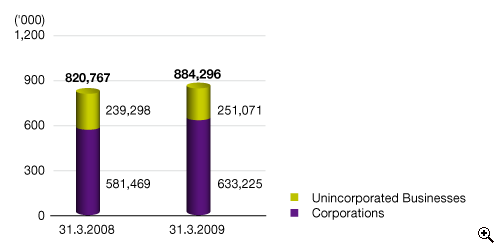
Figure 16 Certificates issued and fees collected
| |
|
2007-08 |
|
2008-09 |
|
Increase / Decrease |
|
| |
Number of certificates issued (Main and Branch) |
856,489 |
|
951,345 |
|
+11.1% |
|
| |
Fees (inclusive of penalties) ($m) |
1,565.8 |
|
154.4 |
|
-90.1% |
|
Under the Business Registration Ordinance, a small business with average monthly sales or receipts below a specified limit ($10,000 for a business mainly deriving profits from the sale of services or $30,000 for other businesses) could apply for exemption from payment of the business registration fee and levy. The number of exemptions granted during the year was 13,737, representing a decrease of 24% from the previous year.
Where an application for exemption is not allowed, the business operator may appeal to the Administrative Appeals Board. Two appeals were received by the Board in 2008-09, but were subsequently withdrawn by the appellant (Figure 17).
Figure 17 Appeals to the Administrative Appeals Board
| |
|
|
|
Number |
|
| |
Awaiting hearing as at 1 April 2008 |
|
|
0 |
|
| |
| Add: |
|
Lodged during the year |
|
|
|
2 |
 |
|
|
| |
|
|
|
2 |
|
| |
|
|
|
|
|
| |
 |
|
Appeal allowed |
|
0 |
|
|
|
| |
 |
|
Appeal dismissed |
|
0 |
|
|
|
| |
 |
|
Appeal withdrawn |
|
2 |
 |
|
|
2 |
 |
|
|
| |
Awaiting hearing as at 31 March 2009 |
|
|
|
|
|
Stamp Duty
Stamp duty is charged on instruments effecting property and stock transactions and leasing of property in Hong Kong (Figure 18).
The global financial turmoil has adversely affected the Hong Kong property market. Both the number and value of transactions decreased significantly in the latter half of 2008-09. The stamp duty collections from property transactions in 2008-09 dropped to $10 billion, representing a 36% decrease when compared with the previous year.
The Hong Kong stock market also suffered a significant downturn. Both the trading value and share price have plummeted sharply. The stamp duty collections from share transactions in 2008-09 decreased to $21.7 billion, a drop of 39% from the previous year.
Overall, there was a decrease of 38% in total stamp duty collections during the year (Figure 19 and Schedule 9). The number of documents being stamped also decreased by 23% (Schedule 10).
Figure 18 Composition of stamp duty collections
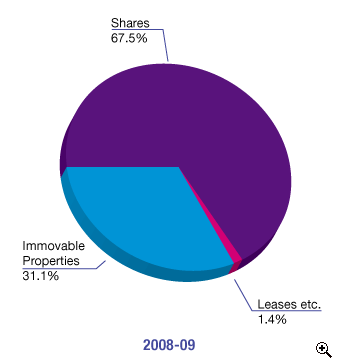
Figure 19 Stamp duty collections
| |
|
2007-08
($m) |
|
2008-09
($m) |
|
Increase / Decrease |
|
| |
Immovable Properties |
15,701 |
|
10,009 |
|
-36% |
|
| |
Shares |
35,447 |
|
21,702 |
|
-39% |
|
| |
Leases etc. |
401 |
|
451 |
|
+12% |
|
| |
Total |
51,549 |
|
32,162 |
|
-38% |
|
|
Estate Duty
Estate duty is charged on that part of a deceased person's estate situated in Hong Kong. The threshold for levying duty is $7.5 million and the duty rates range from 5% to 15%, depending on the value of the estate.
The Revenue (Abolition of Estate Duty) Ordinance 2005 came into effect on 11 February 2006 abolishing estate duty in respect of persons passing away on or after that date. No estate duty affidavits and accounts need to be filed and no estate duty clearance papers are needed for the application for a grant of representation in respect of deaths occurring on or after that date. The estate duty chargeable in respect of estates of persons dying on or after 15 July 2005 and before 11 February 2006, with the principal value exceeding $7.5 million, will be reduced to a nominal amount of $100. Due to the abolition of estate duty, the number of new cases in 2008-09 decreased by 27.8% to 2,082, as compared with last year (Figure 21).
Figures 20 and 21 show the composition of estates and cases processed for the past two years.
Figure 20 Composition of estates

Figure 21 Estate duty cases
| |
|
2007-08 |
|
2008-09 |
|
| |
New cases |
|
|
|
|
| |
Cases finalised |
|
|
|
|
| |
 |
|
Dutiable |
|
159 |
|
74 |
|
| |
 |
|
Exempt |
|
2,893 |
 |
|
|
2,078 |
 |
|
|
| |
|
|
|
|
|
Estate duty of $176 million was collected during the year (Schedule 11), a decrease of $177 million (50.2%) compared with the previous year.
Estate duty is payable on delivery of an estate duty affidavit or account (or within 6 months from the date of the deceased's death, whichever is the earlier). $17 million was received during the year in advance of the issue of formal assessments (Schedule 12).
|
Betting Duty
Since 1 September 2006, the effective date of the Betting Duty (Amendment) Ordinance 2006, betting duty is charged on the net stake receipts derived from the conduct of authorised betting on horse races by the HKJC Horse Race Betting Limited; on the proceeds of lotteries conducted by the HKJC Lotteries Limited and on the net stake receipts derived from the conduct of authorised betting on football matches by the HKJC Football Betting Limited.
In 2008-09, the rates of duty on horse racing, lotteries and football betting remained unchanged (Figure 22).
Figure 22 Rates of betting duty in 2008-09
| |
|
|
|
Rate |
|
|
| |
Horse race betting |
Net stake receipts |
|
|
|
|
| |
|
|
|
72.5% |
* |
|
| |
|
|
|
73% |
|
|
| |
|
|
|
73.5% |
|
|
| |
|
|
|
74% |
|
|
| |
|
|
|
74.5% |
|
|
| |
|
|
|
75% |
|
|
| |
Lotteries |
Proceeds |
|
25% |
|
|
| |
Football betting |
Net stake receipts |
|
50% |
|
|
| Note: * |
For overseas bets, the discount rate for specified places (e.g. Macau) is 40%, whereas the discount rate for a place outside Hong Kong (other than specified places) is 50%. |
In 2008-09, the duty collections from horse racing dropped by 3.87% (Schedule 13). The lotteries duty collections and the football betting duty collections decreased respectively by 5.97% and 0.06%. Total betting duty collections in 2008-09 was 3.28% lower than the previous year (Figure 23).
Figure 23 Betting duty collections
| |
|
2007-08
($m) |
|
2008-09
($m) |
|
Decrease |
|
| |
Horse racing |
8,414.9 |
* |
8,089.2 |
|
-3.87% |
|
| |
Lotteries |
1,686.0 |
|
1,585.3 |
|
-5.97% |
|
| |
Football betting |
2,947.5 |
|
2,945.8 |
|
-0.06% |
|
| |
Total |
13,048.4 |
|
12,620.3 |
|
-3.28% |
|
| Note: * |
Included the "top-up" amount of $119 million for the racing year of 2006-07 – The Hong Kong Jockey Club has provided to the Government a guarantee of $8 billion on the duty on horse race betting in each of the first three years of implementation of the Betting Duty (Amendment) Ordinance 2006. |
|
Hotel Accommodation Tax
Hotel accommodation tax is imposed on hotel and guesthouse accommodations at the specified rate of the accommodation charges paid by guests and is collected quarterly in arrears.
The rate for hotel accommodation tax was 3% on or before 30 June 2008. It was reduced to 0% from 1 July 2008. During the 0% tax rate period, hotels and guesthouses are not required to impose hotel accommodation tax on accommodations hired by the guests and do not need to file the hotel accommodation tax return to the Collector of Stamp Revenue quarterly.
Figures 24 and 25 show the number of hotels and guesthouses, taxable rooms and exempted rooms, and room occupancy rates for the years 2007-08 and 2008-09. As the tax rate was reduced to 0% from 1 July 2008, the 2008-09 collections were made up of tax revenue for the two quarters of January to March 2008 and April to June 2008. The numbers for 2008-09 shown in Figure 24 represents the position as at 30 June 2008. The room occupancy rates in 2008-09 shown in Figure 25 represents the room days and occupancy rate for 6 months from January to June 2008.
Figure 24 Hotels and guesthouses, taxable rooms and exempted rooms
| |
|
2007-08
|
|
2008-09
|
|
| |
Hotels and guesthouses |
230 |
|
236 |
|
| |
Taxable rooms |
53,550 |
|
55,391 |
|
| |
Exempted rooms |
6,947 |
|
7,333 |
|
Figure 25 Room occupancy rates
| |
|
2007-08
|
|
2008-09
|
|
| |
Room days |
15,135,422 |
|
7,930,653 |
|
| |
Occupancy rate |
85.4% |
|
83.8% |
|
With the hotel accommodation tax rate reduced to 0%, the hotel accommodation tax collections in 2008-09 was $222.9 million (Figure 26 and Schedule 14), decreased by 51% as compared with the previous year.
Figure 26 Hotel accommodation tax collections
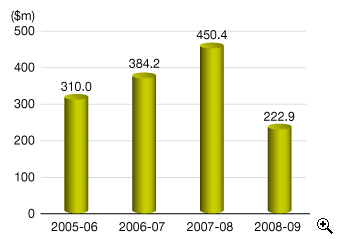
|
Tax Reserve Certificate
Taxpayers may purchase Tax Reserve Certificates (TRCs) under two situations.
The first situation applies to taxpayers who wish to save for the payment of their future tax liabilities. IRD has set up two schemes, namely the "Electronic Tax Reserve Certificates Scheme" for all taxpayers and the "Save-As-You-Earn" (SAYE) Scheme for civil servants and civil service pensioners. With a Tax Reserve Certificate account, taxpayers may purchase TRCs by various channels, including bank autopay, telephone, the Internet and bank ATM. Under the "SAYE Scheme", civil servants and civil service pensioners can purchase TRCs through monthly deductions from their salaries / pensions. Interest is payable on the TRCs when they are redeemed for settlement of tax liabilities, based on the interest rate prevailing at the time of purchase, for a maximum period of 36 months from the date of purchase.
In 2008-09, there was a modest decrease in both the number and the amount of TRCs sold under the "Electronic Tax Reserve Certificates Scheme" and the "SAYE Scheme". The number and the amount of TRCs sold dropped by 1% and 7% respectively under the "Electronic Tax Reserve Certificates Scheme", and by 5% and 9% respectively for the "SAYE Scheme" (Schedule 15). Overall, the total amount of TRCs sold decreased by 8% (Figure 27).
The second situation applies to taxpayers who object to tax assessments and are required to purchase TRCs in respect of the tax in dispute. Such TRCs are used to settle any tax found payable upon the finalisation of the objection or appeal. Interest is only payable on the amount of the TRC, if any, subsequently required to be repaid to the taxpayer, and is computed at floating rates over the tenure of the TRC.
Figure 27 Certificates sold
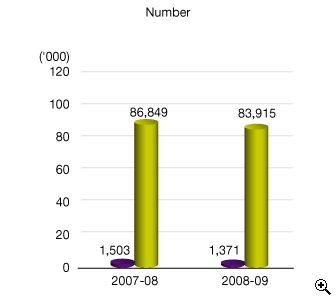
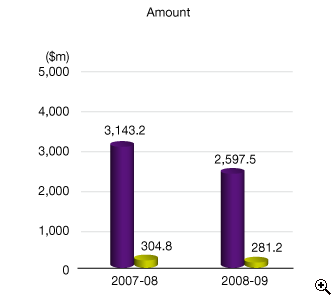

|
|
|